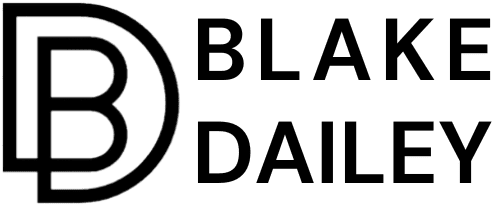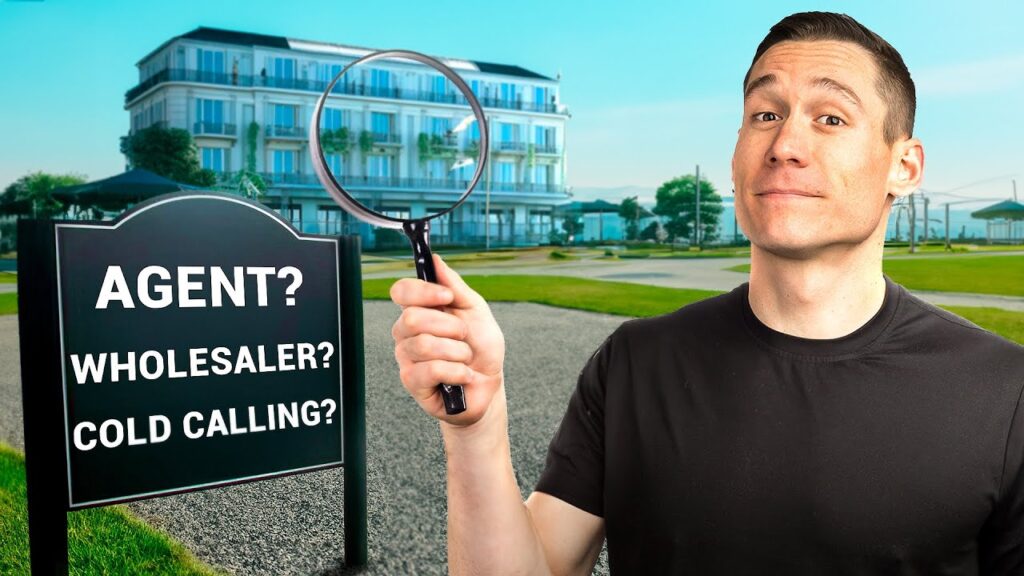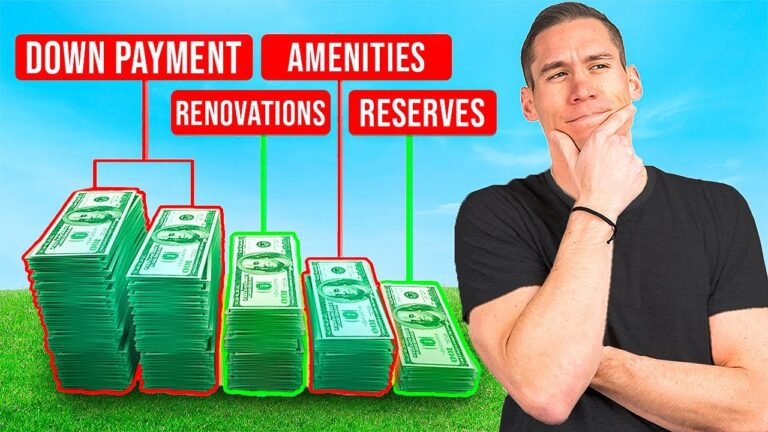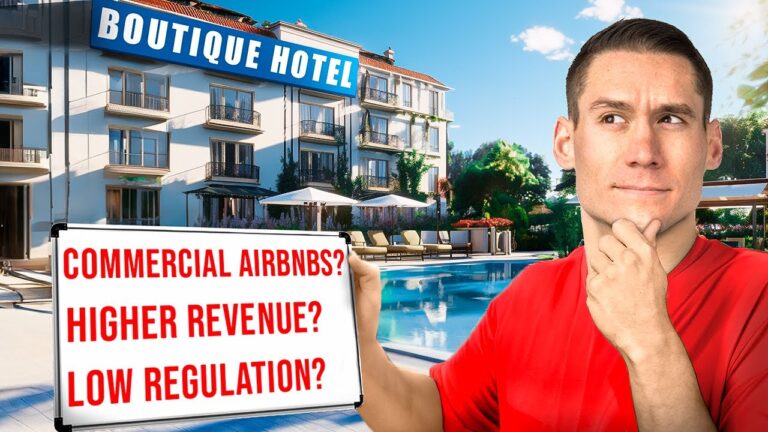If there’s one skill that can get you ahead in the Boutique Hotel game and scaling with STRs, it’s learning how to FIND and ACQUIRE great deals. If you can find a great deal, the other pieces often fall into place, or at least give you much better odds of that happening.
Now if you are having trouble finding boutique hotel deals, what you have is a “top of the funnel” problem. But what the heck is a funnel? Think about it, a funnel is wide at the top and narrows at the bottom, spitting out what you put into the top, in a more concentrated way. So you’re acquisition funnel is what you figuratively pour all of your leads into the top, and you “work the funnel” meaning you screen, analyze, and offer on deals and through that process get deals under contract that spit out at the bottom of the funnel.
When it comes down to it, finding deals is ALL a numbers game. If you want more output, you need more input. That’s because the more deals you find, screen, analyze, and offer – the more deals you will get. Now I know what you may be thinking…. “But Blake, it’s hard to find deals right now and interest rates make it tough to make anything work”. I agree with you, and I’ve personally experienced the same thing. But, when I’ve focused my attention on the “top of the funnel” and increased the sources of and number of deals I’ve screened, I’ve gotten deals. These are the things that work across the real estate industry to fill your inbox with leads. And with the right guidance, you can do it too. So let’s dive into it!
Acquisition Process
When we think about these strategies of finding and getting deals I think it’s important to understand how it fits into the grand strategy of the acquisition process. From a zoomed-out perspective, what we are looking for is value-add boutique hotel deals where we can purchase an underperforming property with potential, renovate and redesign it to turn it into something unique that attracts new, higher paying guests – thereby increasing the net operating income (NOI) and the value of the property. You can have the best operations and the best team in the world (which I’ll show you how to build in an upcoming post), but if you buy wrong you’ll always be working from behind. So it’s imperative in the beginning to find the best deals.
So the acquisition process deserves your focus, especially in the beginning until you get a great deal. None of the other stuff matters until you do, and honestly, if you get a great deal, you can fumble your way through and still be fine. I run my business on the “EOS” system from the book Traction, so I like to systematize my business and measure my actions and results, especially with the entire aspect of finding deals. So for this example, it might be several offers I have to put out to get ONE deal. You can break that down further into the number of leads you get and the deals you analyze, which lead to offers, which then lead to deals.
So I track each one of these things. I want to know how many leads I’m getting each week, how many deals I’m analyzing each week, and the number of offers I’m putting in each week when I’m in this phase. And all of that action is what leads you to getting deals. By tracking each metric, you can see if you are falling short in one area and diagnose the problem. If it’s not enough leads, then increase the top-of-the-funnel inputs. This means calling more brokers, sending more mailers, and so on. And if you are getting leads but can’t efficiently underwrite them to get to the point of putting in an offer, then you have a different problem to diagnose and fix. Maybe it’s bringing on a VA to input the numbers from the T12 that you get from the broker so that you are coming in to do the final analysis and not all the tedious data entry. So the acquisition process breaks down into key steps in the process that you can measure and turn the dial in each area if and when needed. And likely, most of the time it’s going to be a top-of-the-funnel problem. Because if I sent 1,000 potential deals to your inbox right now, there’s a very good chance you could get 1 of those deals to work.
If you want a jump start on all of this and more, I have just the thing for you. I’ve put together a free minicourse to help you find boutique hotel deals. This is the same process I use and I created it so that you can go out and find deals on your own for free. I want my free stuff to be better than the stuff you’d have to pay for elsewhere, so click the link to get access to the free mini course to get a jump on getting into your first deal!
Where to Find Deals
Now, let’s dive into HOW you can find deals because this is where the rubber meets the road.
Number 1: Online listings (The most straightforward, lowest barrier to entry)
Two of the main online deal sources you are going to find, and the easiest to use to get leads, are sites called Crexi and Loopnet. These are like the commercial version of the MLS where commercial brokers list their deals. You may hear that listings only make it here when all of the brokers’ buyer list has already seen it and passed on it, and that is true sometimes. But not all brokers are that good, and you just need to find the ONE. Plus, Crexi specifically does get newly listed properties. Pretty frequently you’ll have sellers who want to shop their deal to the widest audience right from the start, and those will get listed there. That’s exactly what I did when I listed my past hotels because just like my listings on Airbnb, I want the most possible eyeballs on them, and other sellers are the same.
Lucky for you there are also niche sites where you can find boutique hotels, cabin communities, glamping sites, or even B&Bs and those are places like:
- Innshopper.com
- Bizbuysell.com
- NAI Outdoor Hospitality Brokers is another one
These are all tailored sites where you can potentially find some pretty cool and unique stuff.
Number 2: Brokers
It’s hard to say which deal source is the best because they all work, but if I had to pick one and do only that, I’d do this, which is to go through brokers. So most commercial real estate trades with commercial brokers. It’s literally their job to find leads, convince owners to sell or make a relationship with them for when they are ready to sell, and then list the properties. By going to the brokers, you are going straight to the horse’s mouth so to speak. You can get leads from brokers before they hit the wider market, and if you build a relationship with a broker and clearly and repeatedly share your criteria with them, they will call you first when they get a lead that matches what you are looking for. I can’t emphasize enough to find and call commercial hospitality brokers in the areas where you are looking for deals. You can do that by searching for them on Google or by searching on Crexi and Loopnet for the hospitality properties for sale or that have sold and find the listing broker and then reach out to them. A good broker is worth their weight in gold.
Number 3: Off-Market
If you’re really hungry (and I’d advise that if you truly want to find a boutique hotel deal then you need to be hungry), then you can find off-market leads and essentially be your own broker. This is where you identify the ideal deals in your market – either by the “driving for dollars” method or looking online and then reaching out to the owners directly. If you’re physically located in the market you are buying, then drive through the areas that have hotels write down the address, and then go look up the property on the property appraiser’s site get the owner’s contact information, and reach out. It’s really that simple. It might take you more time, and you might find the property is listed in an LLC and then you have to go search the LLC on your state’s Secretary of State website to find the owner’s name and then look up their contact information. But like I said… if you’re hungry. If you are looking in areas you are not physically located in, you can pull a list from all the available hotels or motels in your area using a service like propstream or listsource. I like Listsource because with this strategy you are pulling a very targeted list and you can filter for exactly what you are looking for and pay per lead, as opposed to propstream’s more expensive subscription. Then, once you get the information on the property and the owner, you reach out. Either by direct mail or cold call, email, or however you can get in touch. Then it becomes your ability to sell yourself and negotiate a deal. That’s when it gets fun!
Number 4: Facebook Groups
This deal source might surprise you, but believe it or not I’ve gotten deals from Facebook groups. There are a lot of free groups out there filled with real estate investors who get leads and don’t know what to do with them or maybe they are trying to wholesale them. Whatever the situation is, I know lots of people who have gotten leads and closed deals from Facebook groups. I got the current 130-unit hotel deal that I am working on from a Facebook group that I am in, so it works! And like the other sources, it requires you to be active and do the work and it might not pay off immediately. But like all the methods mentioned here, it adds a tool to your toolbelt to help you better fill the top of your funnel.
Number 5: (This one is simple) Be Vocal!
Simply tell people what you are looking for. Become known for what you do. Boutique hotels are unique and not a lot of people do it, so if you make it known that it’s what you do, then people will naturally think of you when they get boutique hotel leads and send them to you. This happened to me this week and happens pretty frequently. And I get it, you’re not in my situation – but I wasn’t either for a time. If you stay consistent, this one will pay off!
So… all of these deal sources work. What one you use, or which ones you use, because maybe it takes all of them, depends on what you need to do to fill your funnel with enough leads so that you can consistently put out offers until you get a deal. And if you’re not getting deals, remember that there’s money in the follow-up. Don’t just reach out to an owner one time, or put in an offer, get rejected, and move on. Do those things – reach out to owners and get rejected, put out offers and get rejected, but come back and follow up. So much of finding deals is timing, and you want to be there when the seller is ready to sell or when they are ready to come down to a reasonable price. So put out your offers, execute with volume, and then follow up. That is how you get deals. But even the best-executed acquisition strategy can leave you dry if you are taking a singular approach, sometimes you have to get a little…. creative, aka “Creative Finance”.
Creative Finance
Seller Financing
This article about getting deals wouldn’t be worth its salt unless I added some tools to your toolbelt to be able to make more deals with creative strategies. One of the reasons that I like boutique hotels is because you have some unique ways to make a deal that aren’t common in other real estate strategies. After all, they don’t work as well. And the one at the end is going to give you way more opportunities to make deals.
The first “creative finance” strategy I want to equip you guys with is “seller-financing”. This is a pretty simple strategy where essentially the seller becomes the bank. Instead of getting a bank loan and paying the bank every month, the seller does what is called “carry the mortgage” and they become the bank and you pay them every month. This is probably my favorite strategy of all time, anywhere, because it’s so flexible for you as the buyer. You don’t have to go apply for the loan, you don’t have to get your credit pulled, and you don’t have to qualify with your DTI – none of that! You negotiate the terms with the seller and then document that on the purchase and sale agreement, and that’s pretty much it.
Now for the seller to carry the mortgage, they’ll need to have enough equity in the deal. They usually can’t seller-finance if they still owe the bank because the bank has the first position lien on the property. This strategy works if 1) The seller has no mortgage on the property and owns it free and clear (that’s an easy one) and 2) The seller owes only a small amount, like 30% or less because under is what you’d make as a down payment to a bank anyway. Or there’s a tricky 3) The seller is willing to carry a second mortgage on the property and subordinate their debt to the bank which is in the first position. That scenario might look like you assuming the current mortgage or going out to get a 60% LTV (loan to value) loan from a bank to pay off their current mortgage, and then the seller carrying a 20% second mortgage so that you are leveraged up to 80%, and you would bring a 20% down payment. That’s just an example so you know all your options, but the best scenario for seller financing is when the seller has little or no mortgage on the property.
I’ve purchased 3 of my 5 boutique hotel deals so far with seller financing, all with between 10-15% down and interest rates 4-6% with balloons that are 1-3 years in the future (meaning they finance for that period and then the full amount of the loan [the balloon] is due), which you can accomplish by refinancing the property because ideally at that point the property is stabilized and you’re ready to get some cash out to do the next deal or return your investors capital. This is a great strategy and even one worth pursuing exclusively because of the troubles involved in commercial lending right now, especially hospitality, and the high-interest rates. This one strategy could get you well on your way.
After doing this a bunch of times, how I convince sellers to let me pay them over time with less out of pocket is by asking strategic questions to find out if seller-financing is even an option, and if so, I nudge them that way. I like to ask how much they owe, what they plan to do after they sell, what they plan to do with the money from the sale, and even if monthly income would be beneficial to them. I ask questions with genuine interest and then I listen. You’re never going to hard-pitch yourself into seller financing because the seller needs to like and trust you to agree to it.
Partnerships
Another creative strategy that should not be slept on is partnerships. I’ve been able to scale so far and so fast because of partnerships, for the most part still being in control of my destiny. I think the fear is always tying yourself at the hip to someone and the stories of a partnership gone wrong may flash in your mind. But you can do partnerships without compromising your business and keep them limited to the deal. This means you aren’t getting married into a business relationship or dropping all of your pursuits to now only do everything together. You can partner on a specific deal and limit your exposure to that one deal. And that can be great for you and them. You each bring something to the table that the other needs. And if the deal goes well, you can always do the next one together and structure it into something more formal later.
Lease Options
A very underutilized and underappreciated strategy when it comes to picking up commercial deals is a lease option. This strategy can potentially save you in a scenario when no other acquisition strategy will work for you. A lease option has 2 parts. The lease and the option. The lease is just what it sounds like. You lease the property from the owner and become the tenant and they become the landlord. You pay them a fixed lease fee each month, similar to your debt service if you own the property. It’s a consistent monthly income for the owner, with no operational responsibilities for them. You as the tenant do everything. The most common way to structure it is a triple net lease, where you, the tenant, pay for everything including the taxes and insurance. With this strategy, you get to fully run the property and keep all the excess cash flow. It’s very similar to seller financing, but the deed doesn’t change hands. And then the second part is the option, or the option to purchase. This gives you the ability to lock in a price today that you pay to buy the property later down the road when you execute the option. So all the while you are leasing the property, you can be building equity in the difference between what the property is worth thanks to your improvements and operational prowess, and the price that was set for the option. And when you get the NOI up and the property is poised to be able to finance, you can purchase the property and execute the option. Then you fully own it and the lease is gone. This can be great for when sellers are stuck on a price and don’t want to sell yet and don’t want to operate the property. You can afford to give them a higher option price than you could pay today because you don’t have to purchase at that price until down the road once you’ve improved the property. And that is a tool that can help you get a LOT more deals.
And when you put all these things together, that’s when the magic happens. You focus intently on the top of your funnel to get more quality leads from all of the methods I mentioned. And when it comes to putting in your offer to get the deal, you have the creative finance strategies we talked about to convert more leads into deals. And one last tip that I think will be a big help is to put in multiple offers on your deals. Not every seller has the same needs, wants, and desires. So you can structure an all cash or financed offer with an additional creative option that may maybe a higher price but better terms for you. And when the seller is stuck on price, know that you can pretty much pay any price they want IF you get your terms. You can easily buy a property for 20% over what the numbers pencil in today if you get a low-down option with a low interest rate or lease rate and a long enough term. Their price, your terms, or vice versa. It’s all tools in your toolbelt. Talk to you soon!




